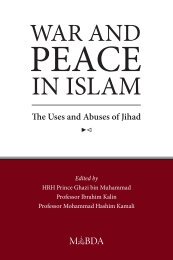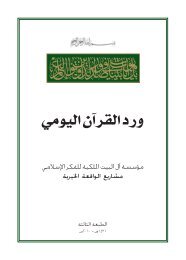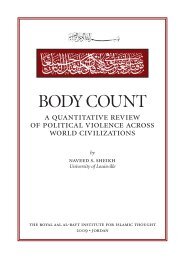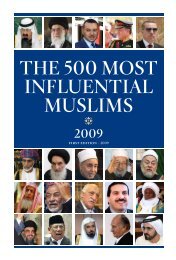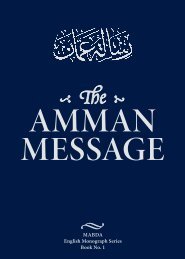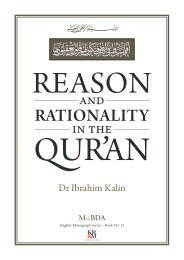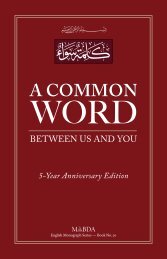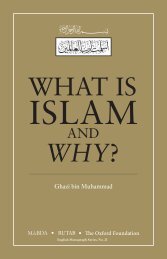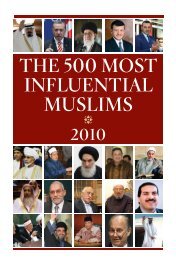Al-W¥^idÏ's Asb¥b al-Nuz‰l - The Royal Islamic Strategic Studies ...
Al-W¥^idÏ's Asb¥b al-Nuz‰l - The Royal Islamic Strategic Studies ...
Al-W¥^idÏ's Asb¥b al-Nuz‰l - The Royal Islamic Strategic Studies ...
Create successful ePaper yourself
Turn your PDF publications into a flip-book with our unique Google optimized e-Paper software.
Asbab <strong>al</strong>-Nuzul<br />
in the form of didactic and legislative univers<strong>al</strong> discourses. This was done only in order to make the religion<br />
easy to understand and to <strong>al</strong>low the scholars to deduct relevant rulings and legislations for as long<br />
as the Muslim community exists. This being the case, the discourses of the Qur’an should not entirely<br />
be confined to parti<strong>al</strong>, particular scenarios for this will annul what is intended by them. Likewise, those<br />
passages of the Qur’an which are certain to be of particular applicability should not be gener<strong>al</strong>ised, just<br />
as the discourses which are applied without restriction should not be restricted and those which are<br />
restricted should not be unrestricted in their applicability. Failing to take this into consideration will lead<br />
to confusion regarding God’s intent in His Revelation. 19<br />
Imam <strong>al</strong>-Wahidi and his Book Asbab <strong>al</strong>-Nuzul<br />
Abu’l-Hasan ‘<strong>Al</strong>i ibn Ahmad ibn Muhammad ibn ‘<strong>Al</strong>i <strong>al</strong>-Wahidi 20 was born in the city of<br />
Nishapur and it is in this same city that he died at an advanced age. He belonged to a family of merchants<br />
who had origin<strong>al</strong>ly come from the city of Sawah, located h<strong>al</strong>fway between Rayy and Hamadhan. 21 According<br />
to Abu Ahmad <strong>al</strong>-‘Askari, the affiliation <strong>al</strong>-Wahidi can be traced back to a family ancestor by the<br />
name of <strong>al</strong>-Wahid ibn <strong>al</strong>-Din ibn Muhrah. 22 <strong>Al</strong>-Wahidi was a poet, philologist, grammarian and Qur’anic<br />
commentator. He was, in fact, hailed as the greatest commentator of the Qur’an of his time. He studied<br />
the different sciences of the Qur’an and Qur’anic exegesis with Abu’l-Qasim ‘<strong>Al</strong>i ibn Ahmad <strong>al</strong>-Busti,<br />
Abu ‘Uthman Sa‘id ibn Muhammad <strong>al</strong>-Hiri (d. 427/1036) and Abu’l-Hasan ‘<strong>Al</strong>i ibn Muhammad <strong>al</strong>-Farisi<br />
(d. 431/1040). But his main teacher in this field was the famous scholar Abu Ishaq Ahmad ibn Muhammad<br />
<strong>al</strong>-Tha‘labi (d. 427/1036) the author of <strong>al</strong>-Kashf wa’l-Bayan ‘an Tafsir <strong>al</strong>-Qur’an, among others. He<br />
studied lexicography and philology with Abu’l-Fadl Ahmad ibn Muhammad <strong>al</strong>-‘Arudi (d. 416/1025),<br />
and grammar with Abu’l-Hasan ‘<strong>Al</strong>i ibn Muhammad <strong>al</strong>-Darir and Abu ‘Imran <strong>al</strong>-Maghribi <strong>al</strong>-M<strong>al</strong>iki<br />
(d. 430/1039). 23 His teachers in Hadith included Abu Tahir ibn Mahmish, the judge Abu Bakr <strong>al</strong>-Hiri,<br />
Abu Ibrahim Isma‘il ibn Ibrahim <strong>al</strong>-Wa‘iz, Muhammad ibn Ibrahim <strong>al</strong>-Muzakki, ‘Abd <strong>al</strong>-Rahman ibn<br />
Hamdan <strong>al</strong>-Nasruyiyy and Ahmad ibn Ibrahim <strong>al</strong>-Najjar. 24 <strong>Al</strong>-Wahidi seems to have enjoyed the patronage<br />
of the Seljuq vizier Nizam <strong>al</strong>-Mulk (d. 485/1092) and, after the death of the latter, he continued to<br />
enjoy the favour and protection of Nizam <strong>al</strong>-Mulk’s brother Abu’l-Qasim ‘Abd <strong>Al</strong>lah <strong>al</strong>-Faqih <strong>al</strong>-Aj<strong>al</strong>l (d.<br />
499/1106).<br />
Imam <strong>al</strong>-Wahidi was a prolific writer even if some of his works have not reached us. Among the<br />
books he authored, in fields other than those of Qur’anic sciences and exegesis, mention can be made<br />
of: <strong>al</strong>-Tahbir fi’l-Asma’ <strong>al</strong>-Husna, Kitab <strong>al</strong>-Da‘awat wa’l-Mahsul, <strong>al</strong>-Ighrab fi’l-I‘rab, Kitab <strong>al</strong>-Maghazi, <strong>al</strong>-<br />
Wasit fi’l-Amth<strong>al</strong> 25 and Sharh Diwan <strong>al</strong>-Mutanabbi. 26 In the fields of Qur’anic studies and Tafsir, <strong>al</strong>-Wahidi<br />
authored the following: Maqatil <strong>al</strong>-Qur’an, from which Ibn Rajab <strong>al</strong>-Hanb<strong>al</strong>i in his Lata’if <strong>al</strong>-Ma‘arif<br />
quotes, 27 Nafy <strong>al</strong>-Tahrif ‘an <strong>al</strong>-Qur’an <strong>al</strong>-Sharif, Tafsir <strong>al</strong>-Nabiyy S<strong>al</strong>la <strong>Al</strong>lahu ‘<strong>al</strong>ayhi wa-S<strong>al</strong>lam. But his<br />
scholarship was perhaps cemented due to his three different commentaries on the Qur’an <strong>al</strong>-Wajiz fi<br />
19<br />
Tafsir <strong>al</strong>-Tahrir wa’l-Tanwir, op. cit., vol. , part 1, p. 50.<br />
20<br />
On the life and works of Imam <strong>al</strong>-Wahidi, see: Yaqut <strong>al</strong>-Hamawi, Mu‘jam <strong>al</strong>-Udaba’: Irshad <strong>al</strong>-Arib ila Ma‘rifat <strong>al</strong>-Adib, Beirut:<br />
Dar <strong>al</strong>-Gharb <strong>al</strong>-Islami, 1993, vol. 4, pp. 1659-1665; Ibn Kh<strong>al</strong>likan, Wafayat <strong>al</strong>-A‘yan wa-Anba’ Abna’ <strong>al</strong>-Zaman, Beirut: Dar <strong>al</strong>-<br />
Thaqafah, n.d., vol. 3, pp. 303-304; Imam <strong>al</strong>-Dhahabi, Siyar A‘lam <strong>al</strong>-Nub<strong>al</strong>a’, Beirut: Dar <strong>al</strong>-Fikr, vol. 13, pp. 627-629; Imam <strong>al</strong>-<br />
Dhahabi, Ta’rikh <strong>al</strong>-Islam wa-Wafayat <strong>al</strong>-Mashahir wa’l-A‘lam, Hawadith wa-Wafayat 461-470, Beirut: Dar <strong>al</strong>-Kitab <strong>al</strong>-‘Arabi, 1994,<br />
pp. 257-260; Ibn Qadi Shuhbah, Tabaqat <strong>al</strong>-Shafi‘iyyah, Hyderabad: Da’irat <strong>al</strong>-Ma‘arif <strong>al</strong>-‘Uthmaniyyah, vol. 1, pp. 277-279. See<br />
<strong>al</strong>so the article ‘<strong>al</strong>-Wahidi’ in the Encyclopaedia of Islam, second edition, for a summary essay on <strong>al</strong>-Wahidi’s life and career.<br />
21<br />
Siyar A‘lam <strong>al</strong>-Nub<strong>al</strong>a’, op. cit., p. 227.<br />
22<br />
Wafayat <strong>al</strong>-A‘yan, op. cit., p. 304.<br />
23<br />
Mu‘jam <strong>al</strong>-Udaba’, op. cit., pp. 1661-1663.<br />
24<br />
Siyar A‘lam <strong>al</strong>-Nub<strong>al</strong>a’, op. cit., p. 628.<br />
25<br />
Edited by ‘Afif Muhammad ‘Abd <strong>al</strong>-Rahman and published in Kuwait in 1975 (cf. <strong>al</strong>-Dhahabi, Ta’rikh <strong>al</strong>-Islam, op. cit., p. 259,<br />
footnote 6).<br />
26<br />
Edited by Friedrich Dieterici, Berlin, 1858-1861. Ibn Kh<strong>al</strong>likan [Wafayat <strong>al</strong>-A‘yan, op. cit., p. 303] thinks it is the best commentary<br />
on the Diwan of <strong>al</strong>-Mutanabbi.<br />
27<br />
See, the introduction to <strong>al</strong>-Wahidi’s Asbab <strong>al</strong>-Nuzul, op. cit., p. 21.<br />
xiv



